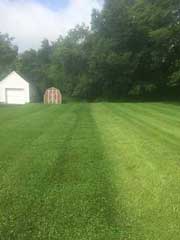Do moles eat grubs? Will killing or preventing grubs get rid of moles?
I’ve often been asked to apply grub control to a lawn for the specific purpose of getting rid of moles. Unfortunately, this is an old wives tale. Of course, moles will eat a grub, or any insect, if it comes across one in the soil. However, a mole’s main source of food is earthworms. You cannot, nor should you want to, eliminate earthworms as they are essential to the natural life of the soil.
Think of it this way, if you run out of apples at your house, you wouldn’t move to a different house with apples because you still have meat and bread and cheese. In much the same way, if you get rid of grubs the moles won’t leave your lawn because there will always be something for them to eat.
The only effective ways that I’ve found to get rid of moles is trapping or baiting. Spring traps are very effective but they do take some skill and planning to use properly.
In conclusion, grub control does not get rid of moles.


